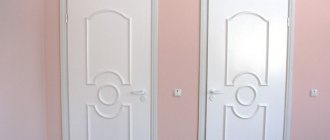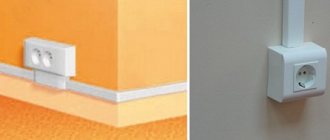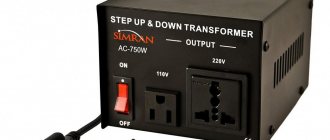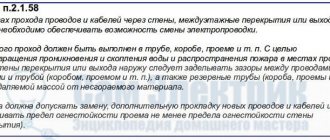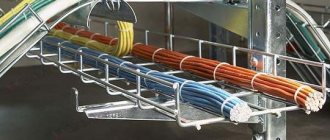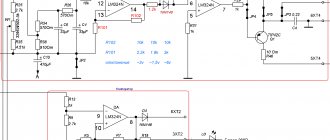Residents of private sectors
How to choose a protective device for private home owners? The principles here are the same, only there are a few additional ones. Firstly, only one phase is carried out in an apartment, but three can be thrown in a private house. In this case, you need to choose a three-phase model. In addition, there may be more sockets and devices, and it is not recommended to install an RCD on each of them, since this requires a lot of space in the panel. You can simply put one thing on several machines, only here you have to calculate the power for the entire group, which is done differently. The only thing is that the input must have a 100 mA device “at least not less”, type - as was said - “S”.
RCD or differential circuit breaker: what to choose
First, let's say what a difavtomat is. Essentially, this is an automatic machine plus an RCD, just in one housing. Which one is better? There is no clear answer here. According to different indicators, one or the other device wins. Let's take a closer look at them:
- connection diagram: in DA “or RCBO” it is simpler;
- searching for the reason for the shutdown. The RCD wins here, since it turns off when there is a current leak, and the machine turns off when the line is shorted or rebooted. YES is disabled in all cases;
- place in the shield. Let's say each machine is protected by an RCD. The first of them takes one place, the defense takes two. That is, for one outlet we need three places. YES takes up only two places, while combining the functions of these two objects. This way you can save some space;
- cost of repair work. If the device fails, it must be replaced. It is cheaper to replace a machine or RCD separately, but they can fail separately for various reasons. But all of them can make YES worthless, since he is two in one;
- price issue. For many, this question can be decisive. So, when connecting a single consumer, the RCD and the machine combined will cost less than YES. When connecting a group of consumers, the combination of circuit breaker and protection will be more expensive, but only on the condition that a separate device is installed on each of them. As a rule, this is done like this: the machines are divided into consumer groups “sockets in the room, lighting, etc.”, and one RCD is installed on each of them “we have already talked about this”.
Then it turns out cheaper than buying YES for each consumer.
What to choose: difavtomat or RCD? Now it’s easier for you to answer this question. Everyone chooses based on their preferences.
Leakage current hazard due to fire
A leakage current of 300 to 500 mA causes the two metals to glow when they come into contact. This means that damage to the insulation of the cable or wires and touching their conductive body will cause heating of the contact points and further fire.
I have already mentioned the dust that accumulates in the inlet and distribution boxes. Moreover, such an emergency situation is likely in networks of all grounding schemes.
To protect against possible fires, an RCD with sensitivity to differential currents of 300 mA, 500 mA is installed.
One more note. The insulation is not destroyed every second, the destruction process is gradual and, accordingly, the leakage current increases gradually. Without an RCD, you may not notice that sparking is occurring somewhere in the shield. It is precisely for this monitoring that fire protection RCDs are installed. In the diagram you see a graph of changes in the state of insulation and electrical wiring as a result of aging.
Related articles: About RCD in simple words
RCD selection parameters
Trip type
RCDs installed in apartments have two types of tripping: A and AC.
AC type devices are triggered by an alternating sinusoidal leakage current that appears suddenly or gradually increases.
Type A devices respond to alternating sinusoidal and constant pulsating leakage currents that arise suddenly or gradually increase (recommended for installation on lines serving household electrical appliances, where rectifiers and switching power supplies are installed: computers, televisions and other equipment equipped with electronics).
Selectivity
A selective RCD (S - with a longer shutter speed, G - with a shorter shutter speed) is installed at the input in front of other devices serving different groups in an apartment or cottage.
It detects a leak, but only triggers after a certain period of time (delay 0.2-0.5 seconds). Thanks to this, groups where there was no leakage are not de-energized.
Number of poles
Depending on the voltage in the network, the number of poles in the device used depends: for a 220 V network - two-pole, for a 380 V network - four-pole.
Rated protection current
The parameter determines how much current the device can carry during continuous operation. The indicator must be equal to or one step higher than that of the circuit breaker protecting the same section of the circuit.
Rated residual current
This indicator determines the leakage current at which the switch will trip. An RCD with a rating of 30 mA is considered universal; it will provide protection against electric shock and fire, and can be used in lines with a fairly large load without false alarms.
Switches with an indicator of less than 30 mA are not always able to ensure fire safety; under significant loads they often operate erroneously.
Nominal trip time
An indicator that determines the time interval between the moment a leak appears and the moment the switch operates. Standards define the maximum permissible response time to 0.3 seconds; high-quality devices operate in 0.02-0.03 seconds.
Operating temperature
Most switches are designed to operate in a temperature range from -5 °C to + 40 °C; if necessary, you can purchase a device capable of responding to temperatures down to -25 °C.
Fire protection RCD for a wooden house
According to the rules for designing electrical installations and fire safety standards, the electrical network at the entrance to an apartment or cottage must have a fire protection RCD. This is a regular differential switch, only it has a higher leakage current value than classic electric shock protection devices.
When choosing such a device designed to prevent fire, a number of conditions must be met. Its installation also requires compliance with specific electrical installation requirements.
General functions of differential switch
In household and industrial electrical networks, several types of protective devices are used to prevent fires and electric shock to people. All of them are designed to be triggered in the event of breakdowns in electrical installations or breakdown of wiring insulation.
The principle of operation, the elements inside and the controlled characteristics are different. However, the task is the same everywhere - if problems arise, quickly break the power supply chain.
You should not confuse RCD and difavtomat; their design and functionality are different.
The first device exclusively monitors the occurrence of leakage current, and the second is also designed to operate in the event of short circuits and overloads in the network
RCD (differential switch) is an electrical device that breaks the power supply line when a high leakage current occurs. The latter occurs when the insulating layer in various thermal electric heaters and wires breaks down.
If at this moment a person touches the body of the broken equipment, then the electric current will flow through it into the ground. And this is fraught with serious injuries. To prevent this from happening, a residual current device (residual current circuit breaker) is installed in the circuit.
The RCD consists of a regular and a fire protection device consisting of:
- housings;
- transformer with three windings;
- EMF relay.
In normal operating condition, the electric current passing through the transformer windings forms magnetic fluxes with different poles. Moreover, when they are added, the final result is zero. The relay in this state is in the closed state and passes current.
Connection diagrams for RCDs in a single-phase network
Most household consumers are powered by a single-phase circuit, where one phase and neutral conductor is used to supply them with electricity.
Depending on the individual characteristics of the network, single-phase power supply can be provided according to the following scheme:
- with a solidly grounded neutral (TT), in which the fourth wire acts as a return line and is additionally grounded;
- with combined neutral and protective conductor (TN-C);
- with separated zero and protective grounding (TN-S or TN-CS; when connecting devices indoors, you will not find any difference between these systems).
It should be noted that in the TN-C system, in accordance with the requirements of clause 1.7.80 of the PUE, the use of differential circuit breakers is not allowed, except for the protection of individual devices with the obligatory combination of zero and ground from the device to the RCD. In any situation, when connecting an RCD, the characteristics of the supply network should be taken into account.
Without grounding
Since not all consumers can boast of having a third wire in their wiring, residents of such premises have to make do with what they have. The simplest circuit for connecting an RCD is to install a protective element after the input circuit breaker and the electric meter. After the RCD, it is important to connect circuit breakers for different loads with the corresponding shutdown current. Please note that the operating principle of RCDs does not provide for disconnecting current overloads and short circuits, so they must be installed together with circuit breakers.
Rice. 1: Connecting an RCD in a single-phase two-wire system
This option is relevant for apartments with a small number of connected devices. Since if there is a short circuit in any of them, shutting down will not bring any noticeable inconvenience, and finding the damage will not take much time.
But, in cases where a sufficiently branched power supply circuit is used, several RCDs with different operating current values can be used.
Rice. 2: connecting an RCD in a branched single-phase two-wire system
In this connection option, several protective elements are installed, which are selected according to the rated current and operation current. As general protection, an incoming 300 mA fire protection RCD is connected here, followed by a neutral and phase cable to the next 30 mA device, one for sockets, and the second for lighting; a pair of 10 mA units are installed for the bathroom and nursery. The lower the response rating is used, the more sensitive the protection will be - such RCDs will operate at a significantly lower leakage current, which is especially important for two-wire circuits. However, it is also not worth installing sensitive automation on all elements, since it has a high percentage of false positives.
With grounding
If there is a grounding conductor in a single-phase system, the use of an RCD is more appropriate. In such a scheme, connecting the protective wire to the device body creates a path for current leakage if the insulation of the wires is broken. Therefore, the protection will operate immediately in the event of damage, and not in the event of electric shock to a person.
Rice. 3: Connecting an RCD in a single-phase three-wire system
Look at the figure; the connection in a three-wire system is made in the same way as a two-wire system, since only a neutral and phase conductor are required for the device to operate. The grounding device is connected only to the protected objects through a separate grounding bus. Zero can also be connected to a common zero bus; from the zero contacts it is routed by wires to the corresponding devices connected to the network.
As in a two-wire single-phase circuit, with a large number of consumers (air conditioner, washing machine, computer, refrigerator and other amenities of civilization), an extremely unpleasant option is the freezing of all of the above electronic circuits with loss of data or disruption of their functionality. Therefore, several RCDs can be installed for individual devices or entire groups. Of course, connecting them will result in additional costs, but will make finding damage a more convenient procedure.
Connecting an RCD for fire protection
The RCD for fire protection is connected to the power supply to the house, after the electric meter and after the general input circuit breaker. You can not install two devices, but install one differential circuit breaker.
Important! If the house plans to install separate circuits on group circuits, then the input RCD should be S type, that is, with a selective response delay, according to the RCD classification.
Related articles: Connecting an RCD
Trip delay (selectivity) RCD
Based on the response time, RCDs are divided into 3 types:
RCDs without a time delay are used to protect people from electric shock and fires due to electrical wiring faults. An RCD without a time delay is installed on the lines of electrical receivers. And they are the first stage of defense.
RCD type S (selective), also called fire protection. This type S RCD operates with a delay (0.2-0.5 seconds), so it does not protect a person, but only protects against fires. A fire protection RCD is installed at the beginning of the line after the input circuit breaker and protects the input cable and the automation connection in the panel, and is also the second stage of the differential. protecting the entire house from fire.
You can determine that this RCD is selective by the letter “S” on the panel, which indicates that the RCD is selective with a time delay for shutdown.
Examples of a single-phase selective fire RCD from ABB with a leakage current of 100 mA and a three-phase fire protection RCD of 300 mA from Schneider Electric.
RCD type S is selected with a rated leakage current of 100-300 mA. A fire RCD with a setting of 100-300 mA is the second stage of protection, and according to the rules, if several RCDs are installed on the same line in a circuit, then each subsequent stage must have a longer response time and current setting.
SP31-110-2003 clause A.4.2 When installing an RCD, selectivity requirements must be consistently met. With two- and multi-stage circuits, the RCD located closer to the power source must have tripping current settings and response time at least three times greater than that of the RCD located closer to the consumer.
If there were no time delay, and we have two RCDs on the line, one for 30 mA, the other for 100 mA, then in case of current leakage, both RCDs would be triggered and a 100 mA RCD would de-energize the entire house. Therefore, in order not to run out into the street in shorts in the cold and turn on the fire-fighting RCD in the street panel, the fire-fighting RCD is selected with a setting sufficient to prevent a fire.
RCD type G, the same as type S, only with a shorter time delay of 0.06-0.08 sec. RCDs are rare, and I had to wait 2-3 months for their “arrival”, which is very inconvenient for me, because... electrical panels freeze for a long time.
RCD function as an element of fire protection
The function of the RCD as an element of fire protection is an additional purpose of the RCD. It does not extinguish fires, it eliminates the possible causes of their occurrence. Let me give you an example. Suppose an input device is installed in the house. This is a separate box installed in a separate room, which is rarely entered by anyone. Over time, dust accumulates in the box, and in very large volumes. The insulation of input cables also deteriorates over time. In such a situation, any contact with the working conductor of the AC housing will lead to sparking and the dust will ignite. So much for the fire.
An RCD installed on the input side will track the contact of the working conductor of the housing, because differential currents will appear and will turn off the supply line before it catches fire.
Let's look at the dangers of wiring a house without an RCD at the input.
Related articles: Fire doors: what they are, why and where they are needed, how to choose
RCD - what is it and how does it work
When deciphering the abbreviation RCD in electrical engineering, we mean a special unit that opens the circuit in the event of an emergency situation in the system. This situation primarily refers to a current leak in an apartment or house caused by a person who touched a bare wire or contact. In this case, the body will be used as a conductor through which the current will flow to the conditional ground, and a power surge will be recorded in the electrical network, measured in thousandths of an ampere (mA).
Conventional automatic fuses do not respond to such surges. They open the circuit only after detecting a current imbalance of 1 to 4 amperes (above the rated value). Only an RCD can save a person from a bare wire - a more sensitive breaker that responds to 10-30 mA. It is he who opens the circuit before the careless user has time to be afraid of the “bite” of the current. As a result, thanks to such a breaker, after contact with a bare wire, we are left with only unpleasant memories, and not serious injury or disability.
In addition, the RCD reacts to dangerous heating of the electrical wiring, which can be caused by either a short circuit or a jump in current characteristics caused by a fault on the line. The device also protects the network from connecting electrical appliances with excessively high power, which heat the wiring to boiler temperature, which is why in electrical engineering it is customary to use a special term - fire protection RCD.
Basic mistakes when connecting an RCD
When connecting an RCD, many people make common mistakes that can have very serious consequences for a person. To avoid them, follow these rules:
the input terminals of the residual current device must be connected only after the corresponding circuit breaker; direct connection to the network is unacceptable; observe the correspondence of neutral and phase contacts, their designation is specifically indicated on the housing; when installing wiring, carefully follow the diagram, especially for objects with branching, a large number of connected objects and several RCDs for them; if there is no grounding conductor in an apartment or house, then it should never be replaced with a wire thrown over heating radiators or water pipes; grounding must be made in accordance with the rules; pay attention to the performance characteristics of the purchased devices (rated operating current and shutdown current) and their compliance with the network parameters, for example, if a current of 50A can flow in the line, then the device should be selected at least 63A.
To protect yourself during connection, follow basic electrical safety rules.
Ratings of fire protection RCD
According to safety standards, a fire protection RCD for a private house or apartment must be 3 times larger in parameters than the downstream protection device:
- By leakage current;
- By response time.
The fire protection RCD category includes devices with a leakage current rating of 100 and 300 mA. The level of operating current and the number of poles do not depend on this parameter. The most popular choice is an RCD with an operating current of 40A or more. The lineup:
- 40 – 100 mA;
- 63 – 100 mA;
- 63 – 300 mA;
- 100 – 300 mA.
If necessary, you can buy a fire protection RCD with a suitable rating and number of poles in accordance with the values of the electrical circuit. To ensure safety in an apartment or house, devices with a selected value of 16-40A are sufficient. This is the level for controlling general lighting and sockets with included household appliances.
Selection of RCD by parameters
After the RCD connection diagram is ready, it is necessary to determine the parameters of the RCD. As you know, it will not save the network from overloads. And from a short circuit too. These parameters are monitored by the circuit breaker. To ensure the safety of all wiring, an input machine is installed at the entrance. After it there is a meter, and then they usually install a fire protection RCD. It is chosen specifically. The leakage current is 100 mA or 300 mA, and the rating is the same as that of the input circuit breaker or one step higher. That is, if the input circuit breaker is set at 50 A, the RCD after the meter is installed at either 50 A or 63 A.
The fire protection RCD is selected according to the rating of the input circuit breaker
Why a step higher? Because automatic protective switches operate with a delay. They can carry a current that exceeds the rated current by no more than 25% for at least an hour. The RCD is not designed for prolonged exposure to high currents, and is likely to burn out. The house will be left without electricity. But this applies to determining the rating of a fire protection RCD. Others are chosen differently.
Rated current
How to choose the RCD rating? It is selected according to the method for determining the rating of the machine - depending on the cross-section of the wire on which the device is installed. The rated current of the protective device cannot be greater than the maximum permissible current for a given wire. To make selection easier, there are special tables, one of them is below.
Table for selecting the rating of the circuit breaker and RCD
In the leftmost column we find the wire cross-section; to the right there is the recommended rating of the circuit breaker. The RCD should have the same. So choosing the rating of the leakage current protective device is not difficult.
Trip current value
When determining this parameter, you will also need an RCD connection diagram. The rated breaking current of the RCD is the value of the leakage current at which the power is turned off on the protected line. This parameter can be 6mA, 10mA, 30mA, 100mA, 500mA. The lowest current - 6 mA - is used in the USA, in European countries, and we don’t even have them for sale. Devices with a maximum leakage current of 100 mA or higher are used as fire protection. They are standing in front of the entrance machine.
For all other RCDs, this parameter is selected according to simple rules:
- Protection devices with a rated shutdown current of 10 mA are installed on lines that go into rooms with high humidity. In a house or apartment, this is the bathroom; there may also be lighting or sockets in the bathhouse, swimming pool, etc. The same shutdown current is set if the line powers one electrical appliance. For example, a washing machine, electric stove, etc. But if there are sockets on the same line, more leakage current is needed.
- An RCD with a leakage current of 30 mA is placed on group power lines. When more than one device is connected.
This is a simple algorithm based on experience. There is another method that takes into account not only the number of consumers, but also the rated current in the protection zone, or rather, the cross-section of the wire, since the rated current of the power supply line depends on this parameter. This is more correct, since it explains how to select the value of the leakage current for a general RCD, for example, and not just for devices that are installed on consumers.
Table for selecting the rated shutdown current for RCDs
It is also necessary to take into account the individual leakage currents of each device. The fact is that on every more or less complex device some small current “leaks away”. Responsible manufacturers indicate it in the specifications. Let’s say there is only one device on the line, but its own leakage current is more than 10 mA, install an RCD with a leakage current of 30 mA.
Monitored leakage current type and selectivity
Different instruments and devices use current of different forms, accordingly, the RCD must control leakage currents of different types.
- AC — alternating current (sinusoidal shape) is monitored;
- A - variable + pulsating (pulses);
- B - constant, pulsed, smoothed variable, variable;
- Selectivity. S and G - with a shutdown time delay (to exclude accidental operations), the G-type has a shorter shutter speed.
Selecting the type of leakage current to be monitored
The RCD is selected depending on the type of load being protected. If digital equipment is connected to the line, either type A is required. The lighting on the line is AC. Type B is, of course, good, but too expensive. It is usually installed in areas with increased danger in production, and very rarely in the private sector or in apartments.
RCDs of class G and S are installed in complex circuits if there are RCDs of several levels. This class is chosen for the “highest” level, then when one of the “lower” ones is triggered, the input protective device will not turn off the power.
Nuances of connecting type S modules
Actually, the nuances are the same as those that accompany the process of connecting standard protective devices.
The terminals of each device have a specific purpose (phase, neutral) and are designated accordingly.
Terminal blocks on the protection device and symbols for connecting electrical lines. Also shown is the designation of the button for performing a test operation for correct operation of the RCD.
During installation, it is unacceptable to change the positions of the terminals regarding their purpose in relation to the power circuits.
If you connect a zero bus instead of a phase, there is at least a risk of failure of the device itself. It is extremely difficult to confuse two points, but in practice this happens.
Another nuance is the adjustment of the module to the existing electrical circuit in terms of current cutoff.
If the design does not include current adjustment options, you should select the correct device according to its technical and operational characteristics.
Finally, a mandatory connection nuance is testing the device in the mode of supplying power to the load circuit.
This function is simple and requires only one action - activation of a special button, which is designated on the case/in the documentation as “Test”.
Checking the RCD for functionality
In the design of the residual current device, to check the operation of the device, there is a “TEST” button, when pressed, the occurrence of an emergency situation is simulated and the power groups of contacts are switched off. However, due to the fact that the specified verification method is indirect, it is advisable to perform a full check of the device’s functionality in a natural way.
Today, the most common option for protection against current leakage to ground is the installation and connection of one (general) RCD
for all electrical wiring. Indeed, the cost of repairs is not the least important, especially since with the correct choice of technical parameters of the device, the latter is quite capable of providing a sufficient level of protection.
In some cases - when the electrical wiring consists of one electrical group, connecting more than one RCD is simply not required. Installing several residual current devices may be justified if there is electrical wiring “divided” into several electrical groups and, of course, has its own certain advantages and disadvantages.
As written at the beginning, one device per apartment (private house) is quite enough. Speaking of safety, by installing several protective devices, you can implement more precise protection against current leakage, individually selecting protection devices with optimal operating parameters for specific electrical appliances.
Thus, installing a separate, more sensitive RCD with a leakage current rating of usually 10 mA, say, for a washing machine, will be justified if the input (general) protection device has a differential shutdown current of 100-300 mA. An introductory, serviceable 30 mA RCD, in the event of a malfunction in the insulation of a household electrical appliance and the occurrence of leakage currents, can operate quite quickly, ensuring the proper level of electrical safety.
Another thing is the ease of operation of electrical wiring with several protection devices; this is undoubtedly an obvious advantage. So, if the insulation of any household electrical appliance is broken, the RCD installed specifically to protect it will trip, de-energizing the dangerous area, and not the entire home.
The main disadvantage of using multiple protection devices is, of course, the higher cost of implementing such a protection option. If you choose it, you should definitely take into account the availability of free space for their installation in the distribution board.
In addition, we must not forget that the RCD is protection against leakage currents to the ground, and not against current overloads and short circuits.
Therefore, after it, a circuit breaker of the required rating must be included in the protected circuit, protecting not only the circuit, but also the protective shutdown device itself when overcurrents occur in this circuit - i.e., space in the panel must be provided for the placement of these circuit breakers.
If there is a shortage of free space in the panel - when the number of RCDs and circuit breakers to protect the planned electrical groups is too large, it is recommended to use differential circuit breakers that combine the functionality of RCDs and circuit breakers - protection against short circuits, long-term current overloads and current leaks to the ground.
Which circuits should be protected using separate residual current devices? These are, first of all, electrical groups that supply sockets in wet rooms: bathrooms, kitchens, balconies, etc. It makes sense to group sockets in living rooms in several units, for example, one RCD per room (2-5 sockets).
Do lighting circuits need to be protected from leakage currents?
Many consider this completely unnecessary, citing the fact that in everyday life, users have practically no contact with lighting fixtures, controlling the light using switches or switches.
It’s hard to argue with this; indeed, our contact with lighting devices is limited, however, it still occurs; From time to time you have to replace burnt out light bulbs or wipe off dust from them.
In addition, manufacturers of all kinds of chandeliers and lamps (including those with bodies made entirely of non-conductive materials) provide for the connection of a grounding conductor. To protect lighting circuits, it is advisable to install one RCD with a leakage current rating of 30 mA that eliminates false alarms.
General functions of differential switch
In household and industrial electrical networks, several types of protective devices are used to prevent fires and electric shock to people. All of them are designed to be triggered in the event of breakdowns in electrical installations or breakdown of wiring insulation.
The principle of operation, the elements inside and the controlled characteristics are different. However, the task is the same everywhere - if problems arise, quickly break the power supply chain.
You should not confuse RCD and difavtomat; their design and functionality are different. The first device exclusively monitors the occurrence of leakage current, and the second is also designed to operate in the event of short circuits and overloads in the network
RCD (differential switch) is an electrical device that breaks the power supply line when a high leakage current occurs. The latter occurs when the insulating layer in various thermal electric heaters and wires breaks down.
If at this moment a person touches the body of the broken equipment, then the electric current will flow through it into the ground. And this is fraught with serious injuries. To prevent this from happening, a residual current device (residual current circuit breaker) is installed in the circuit.
The RCD consists of a regular and a fire protection device consisting of:
- housings;
- transformer with three windings;
- EMF relay.
In normal operating condition, the electric current passing through the transformer windings forms magnetic fluxes with different poles. Moreover, when they are added, the final result is zero. The relay in this state is in the closed state and passes current.
But when a leak occurs, the balance on the windings is disrupted. The automatic switch in question reacts to this by opening the circuit. As a result, the voltage in the network disappears - the broken electrical appliance is de-energized, and the person is no longer in danger. The RCD is triggered literally in a few milliseconds.
Electrical equipment becomes a source of fire when:
- short circuits;
- overloads in the network and/or the electrical installation itself;
- excess leaks associated with insulation degradation.
In the first two cases, protective shutdown is carried out using a difavtomat (thermal electromagnetic release) or by blowing a fuse. For the third situation, there is precisely the RCD under consideration for differential current. There are also special insulation monitoring devices, but they are expensive and are rarely installed in apartment or house panels.
Recommendations for the selection and installation of fire protection RCDs
According to the rules for designing electrical installations and fire safety standards, the electrical network at the entrance to an apartment or cottage must have a fire protection RCD. This is a regular differential switch, only it has a higher leakage current value than classic electric shock protection devices.
When choosing such a device designed to prevent fire, a number of conditions must be met. Its installation also requires compliance with specific electrical installation requirements.
Let's look at the operating features of this device, its scope of application and the key features that you need to pay attention to when choosing this equipment.
General functions of differential switch
In household and industrial electrical networks, several types of protective devices are used to prevent fires and electric shock to people. All of them are designed to be triggered in the event of breakdowns in electrical installations or breakdown of wiring insulation.
The principle of operation, the elements inside and the controlled characteristics are different. However, the task is the same everywhere - if problems arise, quickly break the power supply chain.
You should not confuse RCD and difavtomat; their design and functionality are different. The first device exclusively monitors the occurrence of leakage current, and the second is also designed to operate in the event of short circuits and overloads in the network
RCD (differential switch) is an electrical device that breaks the power supply line when a high leakage current occurs. The latter occurs when the insulating layer in various thermal electric heaters and wires breaks down.
If at this moment a person touches the body of the broken equipment, then the electric current will flow through it into the ground. And this is fraught with serious injuries. To prevent this from happening, a residual current device (residual current circuit breaker) is installed in the circuit.
The RCD consists of a regular and a fire protection device consisting of:
- housings;
- transformer with three windings;
- EMF relay.
In normal operating condition, the electric current passing through the transformer windings forms magnetic fluxes with different poles. Moreover, when they are added, the final result is zero. The relay in this state is in the closed state and passes current.
But when a leak occurs, the balance on the windings is disrupted. The automatic switch in question reacts to this by opening the circuit. As a result, the voltage in the network disappears - the broken electrical appliance is de-energized, and the person is no longer in danger. The RCD is triggered literally in a few milliseconds.
Electrical equipment becomes a source of fire when:
- short circuits;
- overloads in the network and/or the electrical installation itself;
- excess leaks associated with insulation degradation.
In the first two cases, protective shutdown is carried out using a difavtomat (thermal electromagnetic release) or by blowing a fuse. For the third situation, there is precisely the RCD under consideration for differential current. There are also special insulation monitoring devices, but they are expensive and are rarely installed in apartment or house panels.


